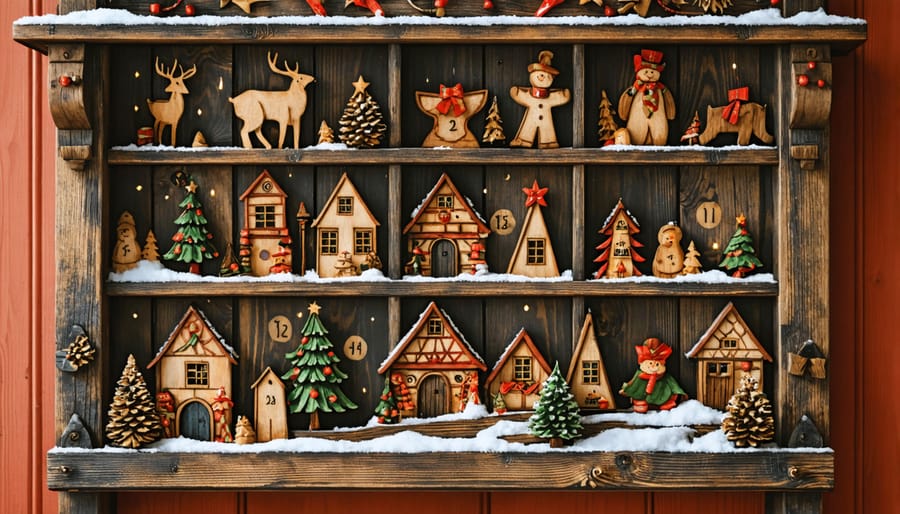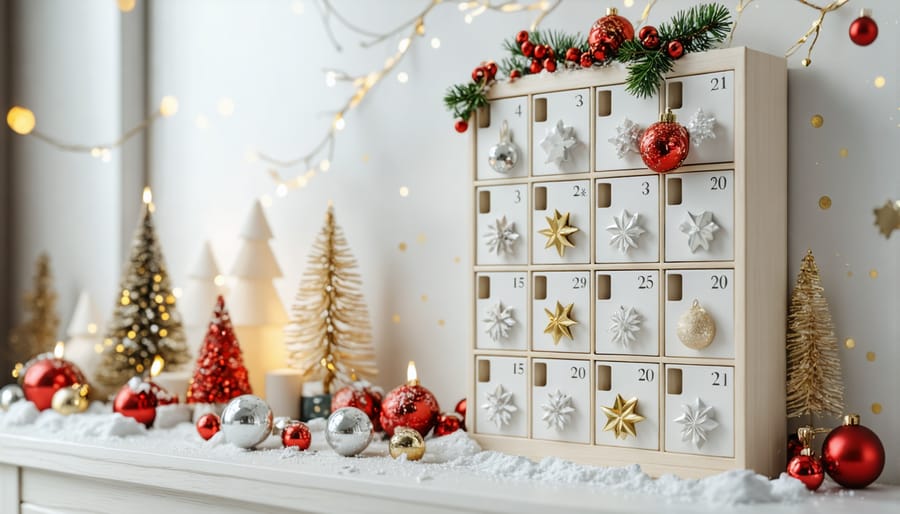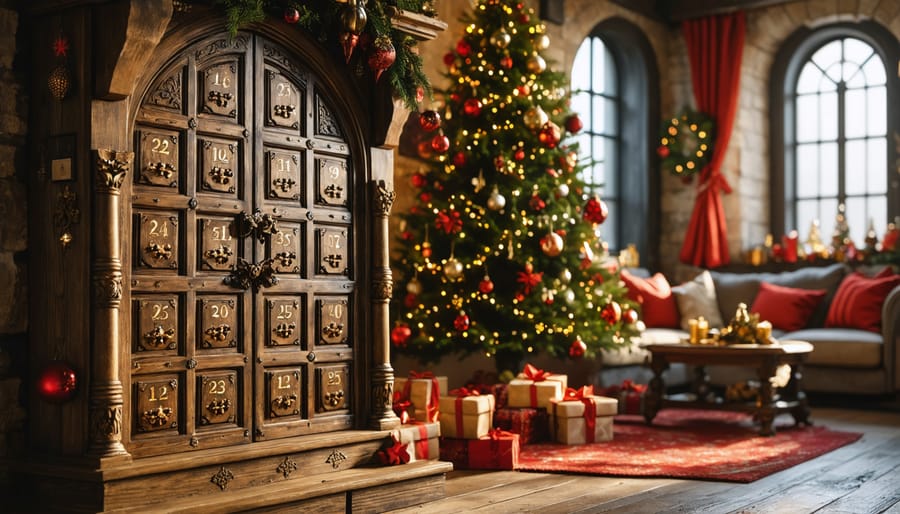Step into a world where each December day unveils a new chapter of human history, transforming the beloved advent calendar tradition into a captivating journey through time. Unlike traditional chocolate-filled calendars, history advent calendars blend the magic of Christmas anticipation with fascinating tales from our past, creating a unique educational experience that spans centuries and continents. From ancient civilizations to modern milestones, these special calendars turn the countdown to Christmas into an exploration of humanity’s greatest moments, discoveries, and achievements. Behind each numbered door lies not just a treat, but a carefully curated historical moment that connects us to generations past, making the holiday season both festive and enlightening. Whether you’re a history enthusiast or simply looking to add deeper meaning to your family’s Christmas traditions, a history advent calendar offers a delightful way to combine learning with holiday cheer, creating memories that blend the wonder of the past with the joy of the present.
The Birth of a Beloved Tradition
From Chalk Marks to Paper Doors
The earliest advent calendars were remarkably simple, with families marking their doors with chalk to count down the days until Christmas. This humble tradition, deeply rooted in German holiday traditions, gradually evolved as families began crafting more elaborate ways to mark the passing days. Children would eagerly await their turn to wipe away each chalk mark, bringing them one day closer to Christmas morning.
By the early 1900s, creative families started cutting windows into paper, creating the first recognizable advent calendars. Each window, when opened, revealed a cherished Bible verse, a festive picture, or a small poem. These handmade treasures were often adorned with glitter, paint, and seasonal illustrations, transforming the simple countdown into an artistic family project that brought everyone together during the holiday season. The paper doors became magical portals, each one holding the promise of Christmas joy and wonder behind its delicate surface.

Gerhard Lang’s Revolutionary Design
In 1908, a German printer named Gerhard Lang forever changed how children countdown to Christmas when he created the first-ever printed advent calendar. Inspired by the childhood memories of his mother crafting him 24 candies attached to cardboard, Lang transformed this personal tradition into a commercial product that would capture hearts worldwide.
His revolutionary design featured 24 colorful pictures that could be cut out and pasted onto a cardboard backing, each one revealing a delightful Christmas scene. Later versions included little doors that children could open, adding an element of surprise and wonder to the daily ritual. Lang’s printing company, Reichhold & Lang, went on to produce increasingly elaborate designs, including the first calendar with chocolate in the 1920s.
Despite facing challenges during the world wars, Lang’s innovative concept survived and thrived, becoming the blueprint for the beloved advent calendars we know today. His simple yet magical idea continues to bring joy to families around the globe, helping create precious holiday memories for generations.
Golden Age of Advent Calendars
Post-War Renaissance
After World War II, advent calendars experienced a remarkable resurgence that transformed them from a predominantly German tradition into a beloved global phenomenon. As families sought to restore joy and normalcy in the post-war years, these festive countdown calendars offered a perfect way to rekindle the magic of Christmas.
The 1950s saw a significant shift in advent calendar production when Sellmer-Verlag, a Stuttgart-based printing company, began exporting their colorful designs to the United States. American soldiers stationed in Germany during the war had fallen in love with these charming calendars and brought the tradition home, sparking widespread interest across the Atlantic.
This period also marked the introduction of chocolate-filled advent calendars, with Cadbury launching their first version in 1971. The innovation captured children’s hearts worldwide and transformed the simple paper calendar into an interactive daily treat. Department stores began featuring elaborate displays, and families embraced the tradition as a way to build anticipation throughout December.
By the 1960s, advent calendars had become a cherished holiday staple in homes across Europe, America, and beyond, symbolizing hope, joy, and the sweet anticipation of Christmas morning.
Chocolate Revolution
The 1950s ushered in perhaps the sweetest revolution in Advent calendar history – the introduction of chocolate-filled calendars. It was German chocolate maker Gerhard Lang who first dreamed up the idea of replacing the traditional pictures with tiny pieces of chocolate, bringing an extra dose of joy to the daily December countdown.
In 1958, Cadbury’s joined the chocolate revolution, launching their first Advent calendar in the UK. Children’s eyes lit up at the prospect of starting each December morning with a small chocolate treat, making the wait for Christmas even more magical. The combination of anticipation and chocolate proved irresistible, and soon these calendars began appearing in homes across Europe and beyond.
These chocolate-filled treasures transformed the simple paper calendar into an interactive experience that delighted all the senses. The ritual of carefully opening each little door, discovering the shaped chocolate within, and savoring that small moment of sweetness became a cherished part of many families’ holiday traditions. The chocolate Advent calendar’s popularity helped spread this German tradition globally, making it the beloved holiday staple we know today.

Modern Interpretations
Digital Age Adaptations
In our increasingly digital world, the beloved advent calendar has embraced technological innovation while maintaining its magical charm. Mobile apps now offer interactive daily surprises, featuring animated characters, festive music, and virtual treats that delight both children and adults. Many of these digital calendars incorporate games, stories, and educational content, making the countdown to Christmas both fun and enriching.
Social media platforms have also transformed how we experience advent calendars, with Instagram and TikTok users sharing daily “unboxing” moments and virtual advent calendar challenges. Some tech companies have created augmented reality advent calendars, where pointing a smartphone at a traditional paper calendar brings characters and scenes to life in 3D.
Email advent calendars have become popular, delivering daily doses of holiday cheer straight to inboxes, while smart home devices offer voice-activated advent experiences, complete with daily Christmas facts, carols, and interactive stories. Museums and cultural institutions have embraced digital advent calendars to showcase their collections, sharing daily artworks and historical artifacts related to the holiday season.
Despite these technological advances, digital advent calendars aim to preserve the essence of anticipation and wonder that makes the traditional calendar so special. They offer new ways for families separated by distance to share the countdown experience, creating virtual connections during the holiday season.
Luxury and Artisanal Calendars
In recent years, the humble advent calendar has undergone a remarkable transformation, evolving into a luxury item that caters to sophisticated tastes and specialized interests. Among the many modern advent calendar options, artisanal versions have captured the hearts of those seeking a more refined countdown to Christmas.
Luxury brands have embraced this beloved tradition, creating exquisite calendars filled with premium chocolates, rare wines, exclusive perfumes, and even fine jewelry. These opulent versions often feature hand-painted illustrations, intricate laser-cut designs, and carefully crafted boxes that become cherished keepsakes long after the holiday season ends.
Artisanal makers have also carved out their own magical niche, offering handcrafted calendars that celebrate local traditions and craftsmanship. From small-batch chocolatiers creating unique flavor combinations to local artists designing one-of-a-kind illustrated windows, these calendars tell stories through their carefully curated contents.
The rise of specialty calendars has introduced creative themes ranging from rare tea collections to organic skincare products, craft spirits, and even gourmet pet treats. Many feature sustainable materials and eco-friendly packaging, reflecting modern values while maintaining the enchanting spirit of anticipation that makes advent calendars so special.
These premium offerings have transformed the tradition into a celebration of craftsmanship and luxury, adding an extra layer of magic to the holiday season while honoring the time-honored practice of counting down to Christmas.

Creating Family Traditions
Creating a history-themed advent calendar can become one of your most cherished festive family activities, weaving together learning and holiday magic. Consider dedicating each December day to a different historical Christmas tradition from around the world. You might include small cards describing how children in Victorian England celebrated Christmas, or share tales of St. Nicholas’s charitable acts throughout history.
Make the experience interactive by incorporating period-appropriate treats and activities. Tuck traditional German lebkuchen recipes behind one door, or instructions for crafting Victorian paper ornaments behind another. Include small pouches of mulling spices with stories about medieval Christmas feasts, or tiny scrolls revealing how different cultures have counted down to Christmas through the centuries.
Add a personal touch by including your own family’s holiday history. Place old family photos, handwritten recipes passed down through generations, or stories of your ancestors’ Christmas celebrations in special compartments. Create milestone markers for your children to add their own memories and traditions, allowing the calendar to evolve into a living document of your family’s holiday journey.
For extra enchantment, design daily activities that transport your family through time. One day might feature carol singing by candlelight, while another could involve creating traditional decorations using methods from different eras. This approach not only teaches children about holiday heritage but also creates lasting memories that bridge past and present, making history come alive during the magical countdown to Christmas.
As we reflect on the enduring legacy of advent calendars, it’s clear why these magical countdown companions have captured hearts across generations. From their humble beginnings in 19th-century Germany to today’s diverse variations, advent calendars continue to weave wonder and anticipation into our holiday celebrations.
These cherished traditions do more than mark time – they create precious moments of connection. Whether it’s parents watching their children’s eyes light up each morning, grandparents sharing stories of their own childhood advent memories, or friends exchanging specially curated calendars, these daily rituals strengthen bonds and build lasting memories.
In our fast-paced modern world, advent calendars offer a gentle reminder to pause and savor the journey to Christmas. They help us resist the urge to rush through December, instead encouraging us to embrace each day’s small joy. Whether filled with chocolates, toys, or handwritten notes, these calendars remind us that the magic of Christmas lies not just in the destination but in the joyful anticipation leading up to it.
As families continue to pass down this tradition, advent calendars remain a testament to the timeless appeal of counting down to Christmas with wonder and delight.










